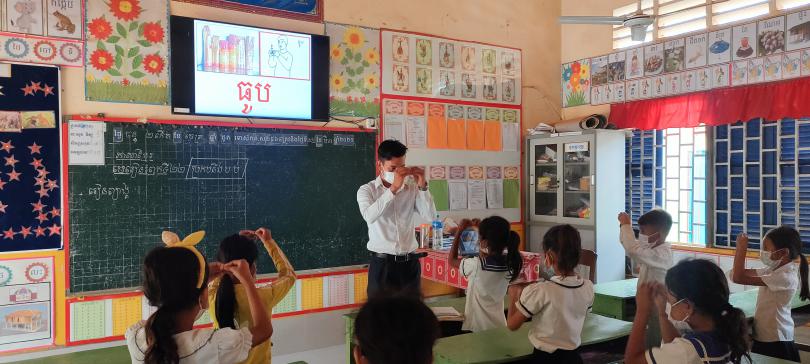Children with disabilities thrive in an Inclusive Classroom

A joyful smile spreads across Chan Noun’s face as she tells us how she is able to use sign language to communicate with the other children in her class. Sitting in a small, but beautifully decorated classroom in Chruk Sdach primary school located in the rural area of Kampong Chhnang province, Noun, a 7-year-old child, tells us with excitement, “I am really happy to learn from my teacher and to play these learning games with my friends.”
“There were noticeable changes in the behaviors of students with disabilities and in my teaching tactics,” said Sok Tith, Noun’s 25-year-old teacher, after receiving support from the Education with Quality and Inclusive Learning (EQUAL) project.
“I am pleased with my new teaching approach. It helps all students in the class enjoy learning together, particularly the children with disabilities,” Mr. Tith said, who has two disabled children in his class. “Now children with disabilities can communicate and make jokes with their friends using sign language.”
Mr. Tith recalled that it was quite challenging to maintain an inclusive learning classroom at first since he had no experience doing this before. He was not aware of effective methods for teaching children with disabilities, or how to set up the classroom to support these children to learn.
Mr. Tith said he often struggled with teaching children with disabilities and had difficulty getting them to interact or engage with him in class. Because of this, children with disabilities often dropped out of school since they could not keep up with Mr. Tith’s lessons.
“Due to the lack of adequate livelihoods, most of the parents in this community did not care about their children’s education – leaving this teaching role entirely to the teachers,” Mr. Tith added.
Because of these factors, the quality of education has declined and the number of absent students has increased, as has the dropout rate, particularly among children with disabilities.
In 2018, with support from Save the Children Korea, Save the Children and its partners have worked closely with the Provincial Office of Education to implement the Education with Quality and Inclusive Learning (EQUAL) project in Chruk Sdach Commune. The project aims to promote effective teaching and learning in schools, especially through improved pedagogy and inclusive, child-friendly teaching techniques.
Mr. Tith has applied what he learned to improve his ability to support children with disabilities. He achieved this by displaying words with associated pictures on a TV screen and by using sign language so all students could learn together. He also taught the other children some sign language so they could communicate and work in groups with children with disabilities.
Within a few months, the children with disabilities were able to participate in exercises with the other children, Mr. Tith said.
“It’s unbelievable that the new methodology works so well for my students – they can understand each other,” said Mr. Tith. “Now, I feel so happy to see the improvements in children with disabilities. They can participate in class happily.”
Remarkably, as parents saw their children’s learning progress, they began actively contributing to the production of study materials using recycled items to ensure their children’s classrooms are attractive and equipped to help them learn. They also follow up on childrens' progress every month.
Things changed for Mr. Tith’s classroom. His students’ learning outcomes are improving and the dropout rate has decreased. With a hopeful smile on his face, Mr. Tith said he would continue learning new methods to respond to the children’s needs, and committed to sharing this experience with other teachers so they could also employ inclusive learning techniques for children with disabilities.





